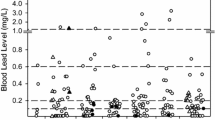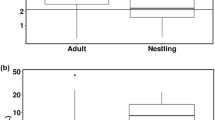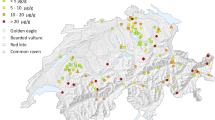Abstract
Lead poisoning of waterfowl, particularly tundra swans (Cygnus columbianus), has been documented in the Coeur d'Alene River Basin in northern Idaho for nearly a century. Over 90% of the lead-poisoned tundra swans in this area that were necropsied have no ingested lead shot. Spent lead shot from hunting activities over the years is therefore a minor source of lead in these swans. The migrating swans accumulated lethal burdens of lead from ingestion of sediments and aquatic vegetation during a short stopover in the spring. The lead originated from mining and smelting activities. Lead concentrations and physiological characteristics of blood were compared in swans captured in swim-in traps, with moribund swans caught by hand in the lead-contaminated area in 1987 and 1994–1995 and with birds captured by night-lighting in reference areas in 1994–1995. Blood lead concentrations in swans were highest in moribund birds (3.3 μg g-1 in 1987 and 1995), intermediate in those trapped in the contaminated area (0.82 μg g-1 in 1987 and 1.8 μg g-1 in 1995), and lowest (0.11 μg g-1) in those trapped in the reference areas. δ-aminolevulinic acid dehydratase (ALAD) was significantly inhibited in swans from the contaminated area. Hematocrit and hemoglobin were significantly depressed only in moribund swans. Of the 19 swans found moribund and euthanized, 18 were classified as having lead toxicosis on the basis of lead levels in blood (1.3 to 9.6 μg g-1) and livers (6 to 40 μg g-1) and necropsy findings. The 19th swan had aspergillosis. There was no evidence that effects of lead on tundra swans had diminished from 1987 to 1995.
Similar content being viewed by others
References
Audet, D.J. (1997). Coeur d'Alene Basin Natural Resource Damage Assessment Biological Reconnaissance Investigation. Final Report U.S. Fish and Wildlife Service, Spokane, WA.
Audet, D.J., Creekmore, L.H., Sileo, L., Snyder, M.R., Franson, J.C., Smith, M.R., Campbell, J.K., Meteyer, C.U., Locke, L.N., McDonald, L.L., McDonald, T.L., Strickland, D. and Deeds, S. (1999). Wildlife use and mortality investigation in the Coeur d'Alene Basin, 1992–1997. Final Report, U.S. Fish and Wildlife Service, Spokane, WA.
Benson, W.W., Brock, D.W., Gabica, J. and Loomis, M. (1976). Swan mortality due to certain heavy metals in the Mission Lake Area, Idaho. Bulletin of Environmental Contamination and Toxicology 15, 171–4.
Beyer, W.N., Audet, D.J., Morton, A., Campbell, J.K. and LeCaptain, L. (1998). Lead exposure of waterfowl ingesting Coeur d'Alene River Basin sediments. J. Environ. Qual. 27, 1533–8.
Blus, L.J. and Henny, C.J. (1990). Lead and cadmium concentrations in mink from northern Idaho. Northwest Sci. 64, 219–23.
Blus, L.J., Henny, C.J., Hoffman, D.J. and Grove, R.A. (1991). Lead toxicosis in tundra swans near a mining and smelting complex in northern Idaho. Arch. Environ. Contam. Toxicol. 21, 549–55.
Blus, L.J., Henny, C.J., Hoffman, D.J. and Grove, R.A. (1993). Accumulation and effects of lead and cadmium on wood ducks near a mining and smelting complex in Idaho. Ecotoxicology 2, 139–54.
Blus, L.J., Henny, C.J., Hoffman, D.J. and Grove, R.A. (1995). Accumulation in and effects of lead and cadmium on waterfowl and passerines in northern Idaho. Environ. Pollut. 89, 311–8.
Blus, L.J., Henny, C.J. and Mulhern, B.M. (1987). Concentrations of metals in mink and other mammals from Washington and Idaho. Environ. Pollut. 44, 307–18.
Burch, H.B. and Siegel, A.L. (1971). Improved method for measurement of delta-aminolevulinic acid dehydratase activity of human erythrocytes. Clin. Chem. 17, 1038–41.
Burrows, G.E., Sharp, J.W. and Root, R.G. (1981). A survey of blood lead concentrations in horses in the north Idaho lead/silver belt area. Vet. Human Toxicol. 23, 328–30.
Campbell, J.K., Audet, D.J., Kern, J.W. Reyes, M. and McDonald, L.L. (1999). Metal contamination of palustrine and lacustrine habitats in the Coeur d'Alene Basin, Idaho. US Fish and Wildlife Service, Spokane, WA.
Chupp, N.R. and Dalke, P.D. (1964). Waterfowl mortality in Coeur d'Alene River Valley, Idaho. J. Wildl. Manage. 28, 692–702.
Day, D.D., Beyer, W.N., Hoffman, D.J., Sileo, L., Audet, D.J. and Ottinger, M.A. (1998). Toxicity of lead contaminated sediment to mute swans (Abst.). SETAC 19th Annual Meeting, Charlotte, NC.
Drewien, R., Clegg, K.R. and Fisher, M.N. (1991). Winter capture of trumpeter swans at Harriman State Park, Idaho and Red Rock Lakes National Wildlife Refuge, Montana. Proc. Trumpeter Swan Soc. 13, 38–46.
Ellis, M.M. (1940). Pollution of the Coeur d'Alene River and Adjacent Waters by Mine Wastes. U.S. Bureau of Fisheries Special Sci. Rep. No. 1. Washington D.C.: U.S. Department of the Interior.
Henny, C.J., Blus, L.J., Hoffman, D.J. and Grove R.A. (1994). Lead in hawks, falcons and owls downstream from a mining site on the Coeur d'Alene River, Idaho. Environ. Monit. Assess. 29, 267–88.
Henny, C.J., Blus, L.J., Hoffman, D.J., Grove R.A. and Hatfield, J.S. (1991). Lead accumulation and osprey production near a mining site on the Coeur d'Alene River, Idaho. Arch. Environ. Contam. Toxicol. 21, 415–24.
Hoffman, D.J., Heinz, G.H., Obrecht, H.H., Sileo, L., Audet, D.J. and LeCaptain, L.J. (1998a). Toxicity of lead-contaminated sediment to goslings (Abst.). SETAC 19th Annual Meeting, Charlotte, NC.
Hoffman, D.J., Heinz, G.H., Sileo, L., Audet, D.J., Campbell, J.K. and LeCaptain, L.J. (1998b). Toxicity of lead-contaminated sediment and nutritional interaction in mallard ducklings Abst.). SETAC 19th Annual Meeting, Charlotte, NC.
Horowitz, A.J., Elrick, K.A. and Cook, R.B. (1993). Effect of mining and related activities on the sediment trace element geochemistry of Lake Coeur d'Alene, Idaho, USA. Part I: Surface sediments. Hydrol. Proc. 7, 403–423.
Javorka, E. (1991). Lake water quality assessment Coeur d'Alene Lake. Benewah and Kootenai Counties, Idaho. Coeur d'Alene Basin Interagency Group, Coeur d'Alene Tribe of Idaho, Plummer, ID.
Krieger, R.I. (1990). Toxicity and bioavailability studies of lead and other elements in the lower Coeur d'Alene River. Idaho BLM Tech. Bull. No. 90–3.
Pain, D.J. (1987). Lead poisoning in waterfowl: an investigation of sources and screening techniques. PhD thesis. University of Oxford, Oxford, U.K.
Pain, D.J. (1996). Lead in waterfowl. In W.N. Beyer, G.H. Heinz and A.W. Redmon-Norwood (eds.) Environmental Contaminants in Wildlife: Interpreting Tissue Concentrations. Boca Raton, FL: CRC Press, Inc.
Paullin, D.G. and Kridler, E. (1988). Spring and fall migration of tundra swans dyed at Malheur National Wildlife Refuge, Oregon. Murrelet 69, 1–9.
Rabe, F.W. and Flaherty, D.C. (1974). The river of green and gold. Idaho Research Foundation, Inc., Natural Resources Series No. 4.
SAS Institute Incorporated (1996). SAS user's guide: statistics. Version 6.12 ed. Cary, NC: SAS Instit. Incorp.
USFWS and EcoChem, Inc. (1995). Coeur d'Alene Basin NRDA Wildlife Injury and Biological Pathway Studies—Quality Assurance Plan. Spokane, WA.
Woodward, D.F., Goldstein, J.N. and Farag, A.M. (1997). Cutthroat trout avoidance of metals and conditions characteristic of a mining waste site: Coeur d'Alene River, Idaho. Trans. Am. Fish Soc. 126, 699–706.
Author information
Authors and Affiliations
Corresponding author
Rights and permissions
About this article
Cite this article
Blus, L.J., Henny, C.J., Hoffman, D.J. et al. Persistence of High Lead Concentrations and Associated Effects in Tundra Swans Captured Near a Mining and Smelting Complex in Northern Idaho. Ecotoxicology 8, 125–132 (1999). https://doi.org/10.1023/A:1008918819661
Issue Date:
DOI: https://doi.org/10.1023/A:1008918819661




